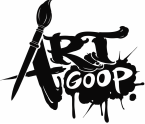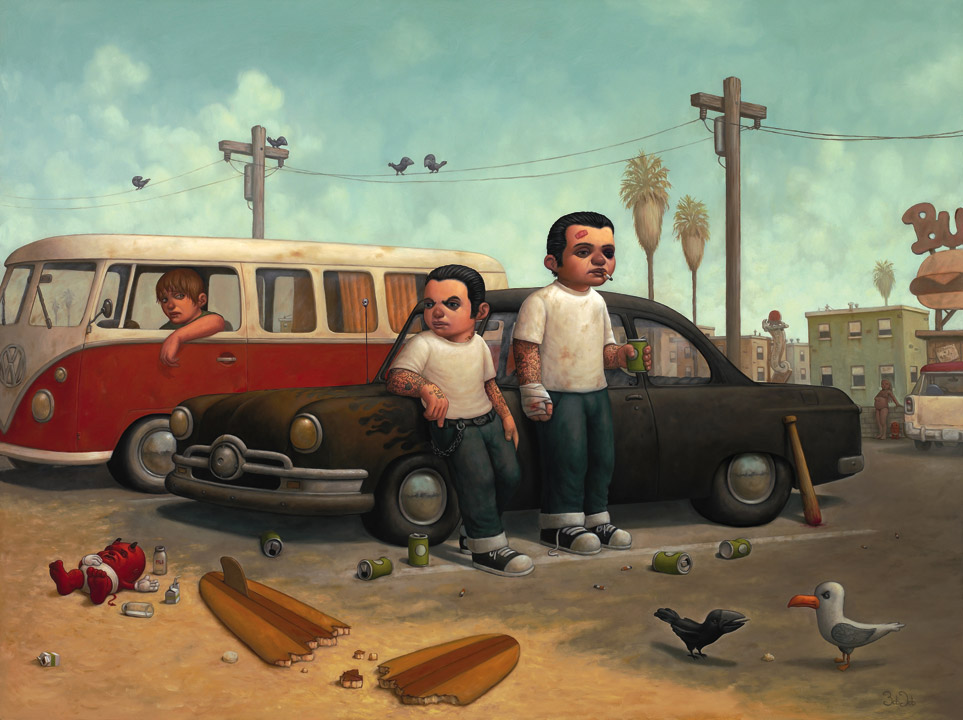|
1. Who were your teachers or influences?
I had many teachers at Otis but the one's I learned the most valuable skills from were Jim Auckland, Barry Jackson, Robert Kalafut and Nathan Ota. My influences as far as artists go were John Pound (Garbage Pail Kids), Roberto Parada, Edward Hopper, and Oink comic creator John Muir. 2. What techniques or tricks did you find most useful when learning to paint? The most useful technique is to have a strong drawing, especially if your painting has a lot of detail. You don't wanna spend time trying to figure details out in the painting stage. If you have a spontaneous style then try and have an idea of the scale and composition of your subject matter in a rough sketch. That and patience, because your painting will look like crap for 70% of the journey but then starts to come together suddenly. It's different for every painting though. 3. What are 3 key principles of making good art, in your opinion? 1. Concept: Your art should always communicate a message. The viewer should feel some kind of emotion when viewing your work. 2. Craft: A well crafted work of art can elevate your concept to another level. 3. Scale: The size is very important whether its small or large. Many times I've been to an art opening and seen a work and thought that would have been better smaller or larger. 4. What are the most common mistakes that you see other artists make? People copying other contemporary artists. Some artists flat out lift the technique and subject matter. Social media is partly to blame because they reward such artists. I always recommend being influenced by artists and art movements from the past. Don't be inspired by artists currently working. I still love to look at Edward Hopper and a lot of illustrators from the Golden Age of Illustration (1900-1940's). 5. Can you break your painting process down into 10 steps, or less, for us? 1. Concepts and rough sketches in sketch book or any piece of paper. Sometimes a post-it I did a sketch on ends up being a good starting point. 2. I'll keep drawing the composition over and over with tracing paper til something works. 3. Do a Tight Drawing of one of the rough sketches that works usually on vellum or tracing paper. 4. Scan in and import into photoshop. I'll move things around and scale up or down certain objects or people . 5. Gesso primed polyester canvas thats been stretched over deerskin panel. I don't like the canvas to be flimsy when I paint, so the deerskin panel gives it nice firm feel. 6.Borrow Greg Simkins projector and project drawing onto canvas. 7. Tone the canvas with with transparent sienna glaze (transparent paint with Gamblin Galkyd medium) 8. Working background to foreground, I'll block in paint going dark-to-light. 9. Once everything is blocked in, I'll start glazing in details oil it's done. 10. Once it's dry I'll varnish or glaze Indian yellow over it. 6. What colors are currently on your palette? Titanium White Ochre Yellow Cad yellow Mars Orange Cad Red Light Cad Red Medium Alizarin Crimson Prussian Blue Caribbean blue Sap green Burnt sienna Burnt umber Van dyke brown Chromatic Black 7. Do you have a paint color or medium or other art-related implement that is indispensable? If so, what is so useful about it? The medium I use is 50% Gamblin Galkyd 50% gamsol
0 Comments
|
Art GoopArt Goop is a Q&A for artists by artists. We ask questions designed to examine the techniques and methods of some of the most inspiring artists working today. Categories
All
Archives
September 2017
|


 RSS Feed
RSS Feed